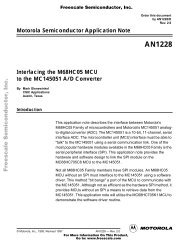MC145146DW2 - LANSDALE Semiconductor Inc.
MC145146DW2 - LANSDALE Semiconductor Inc.
MC145146DW2 - LANSDALE Semiconductor Inc.
You also want an ePaper? Increase the reach of your titles
YUMPU automatically turns print PDFs into web optimized ePapers that Google loves.
ML145146<br />
<strong>LANSDALE</strong> <strong>Semiconductor</strong>, <strong>Inc</strong>.<br />
DESIGN CONSIDERATIONS<br />
CRYSTAL OSCILLATOR CONSIDERATIONS<br />
The following options may be considered to provide a reference<br />
frequency to Motorola’s CMOS frequency synthesizers.<br />
The most desirable is discussed first.<br />
Use of a Hybrid Crystal Oscillator<br />
Commercially available temperature–compensated crystal<br />
oscillators (TCXOs) or crystal–controlled data clock oscillators<br />
provide very stable reference frequencies. An oscillator<br />
capable of sinking and sourcing 50 µA at CMOS logic levels<br />
may be direct or DC coupled to OSCin. In general, the highest<br />
frequency capability is obtained utilizing a direct coupled<br />
square wave having a rail–to–rail (VDD to VSS) voltage<br />
swing. If the oscillator does not have CMOS logic levels on the<br />
outputs, capacitive or AC coupling of OSCin may be used.<br />
OSCout, an unbuffered output, should be left floating.<br />
For additional information about TCXOs and data clock<br />
oscillators, please consult the latest version of the eem<br />
Electronic Engineers Master Catalog, the Gold Book, or similar<br />
publications.<br />
Design an Off–Chip Reference<br />
The user may design and off–chip crystal oscillator using<br />
ICs specifically developed for crystal oscillator applications,<br />
such as the ML12061 MECL device. The reference signal from<br />
the MECL device is AC coupled to OSCin. For large amplitude<br />
signals (standard CMOS logic levels), DC coupling is<br />
used. OSCout, an unbuffered output, should be left floating. In<br />
general, the highest frequency capability is obtained with a<br />
direct–coupled square wave having rail–to–rail voltage swing.<br />
Use of the On–Chip Oscillator Circuitry<br />
The on–chip amplifier (a digital inverter) along with an<br />
appropriate crystal may be used to provide a reference source<br />
frequency. A fundamental mode crystal, parallel resonant at the<br />
desired operating frequency, should be connected as shown in<br />
Figure 8.<br />
For VDD = 5.0 V, the crystal should be specified for a loading<br />
capacitance. CL, which does not exceed 32 pF for frequencies<br />
to approximately 8.0 MHz, 20 pF for frequencies in the<br />
area of 8.0 to 15 MHz, and 10 pF for higher frequencies. These<br />
are guidelines that provide a reasonable compromise between<br />
IC capacitance, drive capability, swamping variations stray in<br />
IC input/output capacitance, and realistic CL values. The shunt<br />
load capacitance, CL, presented across the crystal can be estimated<br />
to be:<br />
The oscillator can be “trimmed” on–frequency by making a<br />
portion or all of C1 variable. The crystal and associated components<br />
must be located as close as possible to the OSCin and<br />
OSCout pins to minimize distortion, stray capacitance, stray<br />
inductance, and startup stabilization time. In some cases, stray<br />
capacitance should be added to the value for Cin and Cout.<br />
Power is dissipated in the effective series resistance of the<br />
crystal, Re. In Figure 10 The drive level specified by the crystal<br />
manufacturer is the maximum stress that a crystal can withstand<br />
without damaging or excessive shift in frequency. R1 in<br />
Figure 8 limits the drive level. The use of R1 may not be necessary<br />
in some cases (i.e. R1 = 0 ohms).<br />
To verify that the maximum DC supply voltage does not<br />
overdrive the crystal, monitor the output frequency as a function<br />
of voltage at OSCout. (care should be taken to minimize<br />
loading.) the frequency should increase very slightly as the dc<br />
supply voltage is increased. An overdriven crystal will decrease<br />
in frequency or become unstable with an increase in supply<br />
voltage. The operating supply voltage must be reduced or R1<br />
must be increased in value if the overdrive condition exists.<br />
The user should note that the oscillator start–up time is proportional<br />
to the value of R1.<br />
Through the process of supplying crystals for use with<br />
CMOS inverters, many crystal manufacturers have developed<br />
expertise in CMOS oscillator design with crystals. Discussions<br />
with such manufacturers can prove very helpful. See Table 1.<br />
where<br />
Cin = 5.0pF (See Figure 9)<br />
Cout = 6.0pF (See Figure 9)<br />
Ca = 1.0pF (See Figure 9)<br />
CO = the crystal’s holder capacitance (See Figure 10)<br />
C1 and C2 = external capacitors (See Figure 8)<br />
Page 8 of 12 www.lansdale.com<br />
Issue 0






